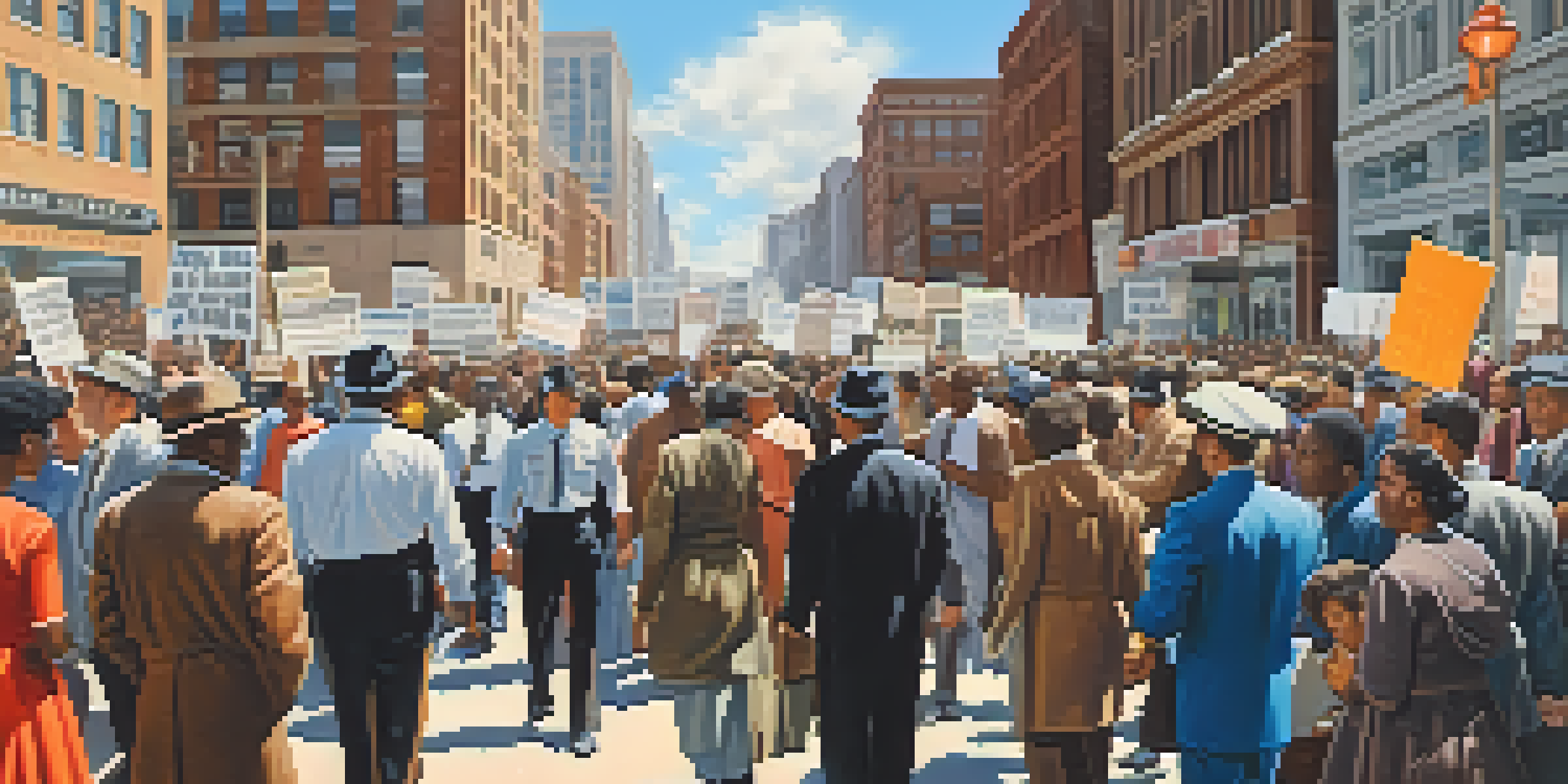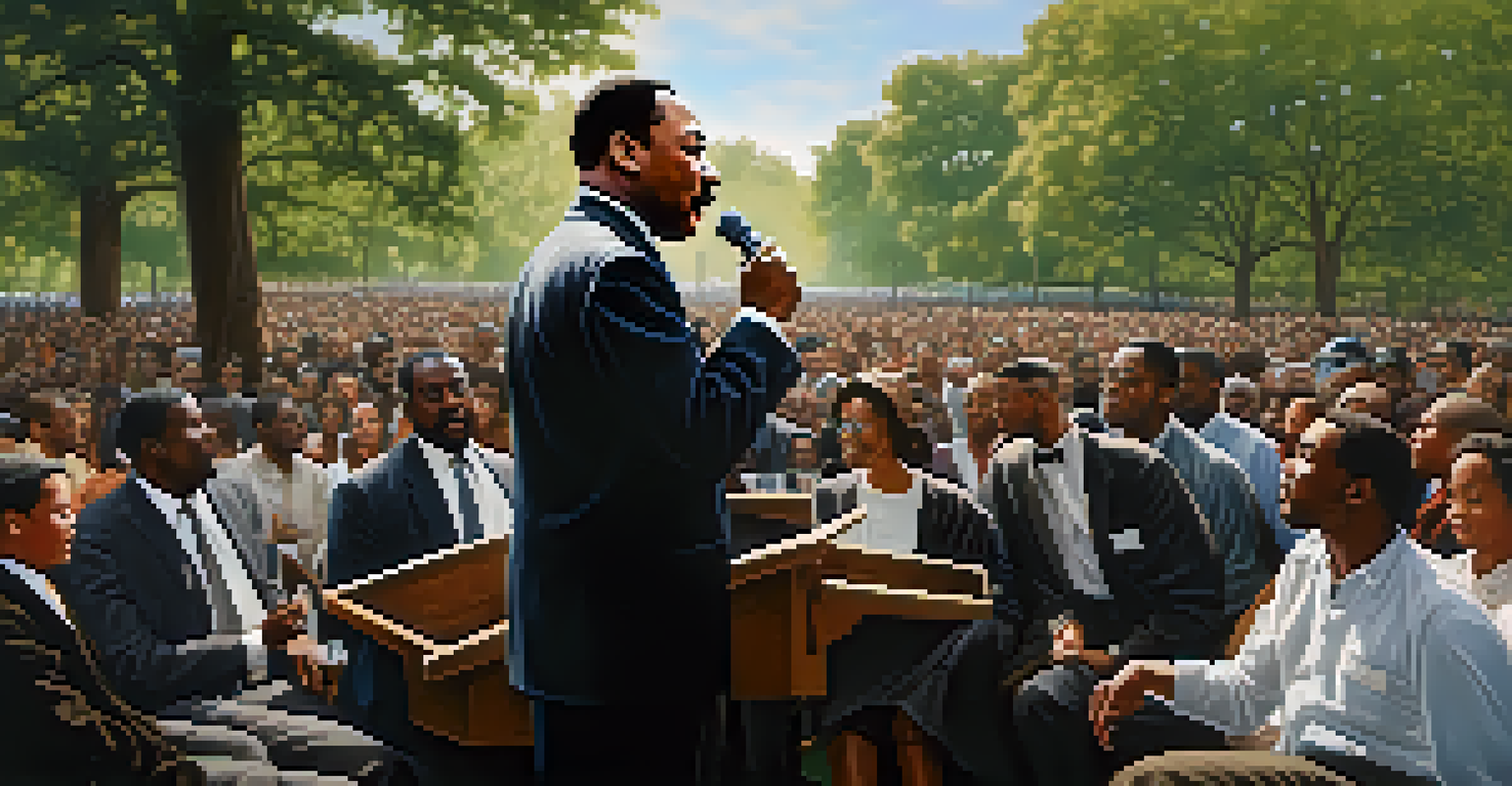Key Figures of Chicago's Civil Rights Movement: Activists and Leaders

Introduction to Chicago's Civil Rights Movement
Chicago's Civil Rights Movement was a powerful force for change in the 1960s, addressing racial injustice and inequality. Activists came together to fight for equal rights, often facing significant resistance. This vibrant movement was characterized by protests, marches, and grassroots organizing aimed at raising awareness and effecting policy change.
Injustice anywhere is a threat to justice everywhere.
Key events, such as the Chicago Freedom Movement led by Martin Luther King Jr., highlighted the struggle for fair housing and education. The efforts of local leaders and grassroots organizations played an integral role in these initiatives. Together, they forged a path toward greater social justice.
Understanding the figures behind this movement is crucial to appreciating the ongoing fight for civil rights today. The stories of these activists serve as a reminder of the importance of community, collaboration, and courage in the face of adversity.
Martin Luther King Jr. and the Chicago Freedom Movement
Martin Luther King Jr. was a pivotal figure in the Civil Rights Movement, and his involvement in Chicago in the 1960s was groundbreaking. He sought to extend the movement's efforts from the South to the urban North, emphasizing the importance of confronting housing discrimination. His work in Chicago culminated in the Chicago Freedom Movement, which aimed to address systemic racism and economic inequality.

King's strategy involved peaceful protests, marches, and community organizing, bringing national attention to local issues. The movement highlighted the struggles faced by African Americans in Chicago, emphasizing that civil rights were not just a Southern issue. It was during this time that he famously stated, 'Injustice anywhere is a threat to justice everywhere.'
Unity Fueled Chicago's Activism
The Civil Rights Movement in Chicago thrived on the collective efforts of diverse activists working together to confront racial injustice.
The impact of King's leadership in Chicago was profound, inspiring local activists and residents alike. His commitment to nonviolent resistance resonated with many, helping to galvanize support for the movement. Today, his legacy continues to inspire new generations in the fight for equality.
Ralph Abernathy: Co-Leader of the Movement
Ralph Abernathy was a close associate of Martin Luther King Jr. and played a vital role in the Chicago Freedom Movement. As a co-leader, he brought his experience and dedication to the fight for civil rights in Chicago. Abernathy's focus on economic justice complemented King's vision, creating a comprehensive approach to addressing racial inequality.
I am somebody.
His leadership style was marked by compassion and a deep commitment to the cause. Abernathy believed in the power of grassroots organizing and often worked closely with local communities to empower them. This collaboration was essential for building solidarity among diverse groups in Chicago.
Abernathy's contributions extended beyond Chicago, impacting the national civil rights landscape. His ability to mobilize and inspire others helped to create a sense of unity within the movement. Today, his legacy serves as a reminder of the importance of collaboration in the pursuit of justice.
The Role of the Chicago Urban League
The Chicago Urban League was instrumental in advocating for African American rights and economic empowerment during the Civil Rights Movement. Founded in 1916, this organization focused on addressing issues such as job discrimination and housing inequality. Under the leadership of figures like Earl B. Dickerson, the League became a vital voice for change in Chicago.
By providing education and resources, the Urban League aimed to uplift the African American community and promote social and economic justice. Their efforts included organizing job fairs and advocating for policy changes at the local level. This grassroots approach helped to build a foundation for the civil rights agenda in Chicago.
Women Played Key Leadership Roles
Women leaders, often overlooked, were instrumental in organizing and mobilizing communities for civil rights in Chicago.
The League's work was critical in bridging the gap between community needs and political action. Their advocacy laid the groundwork for future initiatives aimed at achieving equality. Today, the Chicago Urban League continues to be a key player in promoting social justice and economic development.
Jesse Jackson: A Voice for the Voiceless
Jesse Jackson emerged as a prominent leader in the Civil Rights Movement, known for his passionate advocacy and charisma. He founded the Rainbow/PUSH Coalition, which aimed to address issues of social justice, economic equality, and political representation. Jackson's ability to mobilize diverse groups made him a powerful voice for the voiceless in Chicago and beyond.
His work included organizing protests, advocating for fair housing, and promoting economic opportunities for marginalized communities. Jackson's famous phrase, 'I am somebody,' resonated deeply, inspiring countless individuals to stand up for their rights. His emphasis on dignity and respect for all people became a cornerstone of his activism.
Jackson's legacy is marked by his commitment to social justice and his ability to connect with people from all walks of life. He continues to be a significant figure in American politics and civil rights advocacy. Today, his work serves as a reminder of the ongoing struggle for equality and the importance of having a voice in the fight against injustice.
The Impact of the Black Panther Party
The Black Panther Party played a crucial role in the civil rights landscape of Chicago during the 1960s. Founded in 1966, the party aimed to combat systemic racism and police brutality while advocating for self-defense and community empowerment. Their presence in Chicago marked a shift in the civil rights narrative, emphasizing the need for direct action and community control.
The Panthers organized community programs, such as free breakfast programs for children and health clinics, demonstrating their commitment to social justice. These initiatives directly addressed the needs of the Black community, showcasing a model of grassroots activism. Their work inspired many and encouraged a sense of pride and empowerment among African Americans.
Ongoing Fight for Equality
The legacy of Chicago's Civil Rights Movement serves as a reminder that the struggle for equality and justice continues today.
While the Black Panther Party faced significant opposition and scrutiny, their impact on the civil rights movement was undeniable. Their bold approach challenged traditional methods of activism and highlighted the importance of addressing systemic issues. Today, the legacy of the Black Panther Party continues to influence discussions about race and justice in America.
Remembering the Women Leaders of the Movement
While many male leaders are often highlighted in discussions about the civil rights movement, women played an equally vital role in Chicago. Figures like Gwendolyn Brooks and Fannie Lou Hamer were instrumental in advocating for equality, often working behind the scenes to mobilize communities. Their contributions remind us that the fight for civil rights was a collective effort involving voices from all genders.
Women organized grassroots efforts, led protests, and supported local initiatives, often juggling multiple responsibilities. Their resilience and determination were key to sustaining the momentum of the movement. By recognizing the contributions of women, we gain a fuller understanding of the complexities of the struggle for civil rights.

Today, the legacy of these women leaders continues to inspire new generations of activists. Their stories serve as a testament to the power of collective action and the importance of inclusion in the fight for justice. Remembering their contributions is essential to honoring the history of the civil rights movement in Chicago.
Lessons from Chicago's Civil Rights Movement
The civil rights movement in Chicago offers valuable lessons that remain relevant today. It teaches us about the power of unity and collaboration in the face of adversity. Activists from diverse backgrounds came together to fight for a common cause, showing that collective action can lead to meaningful change.
Moreover, the movement illustrates the importance of grassroots organizing and community engagement. Many of the strategies employed by activists centered on building relationships and empowering local communities. This approach reinforces the idea that real change often comes from within, driven by the people most affected by injustice.
Finally, the legacy of Chicago's civil rights movement reminds us that the fight for equality is ongoing. While significant progress has been made, issues of inequality and injustice persist. By learning from the past and honoring the contributions of those who fought for civil rights, we can continue to advocate for a more just society.